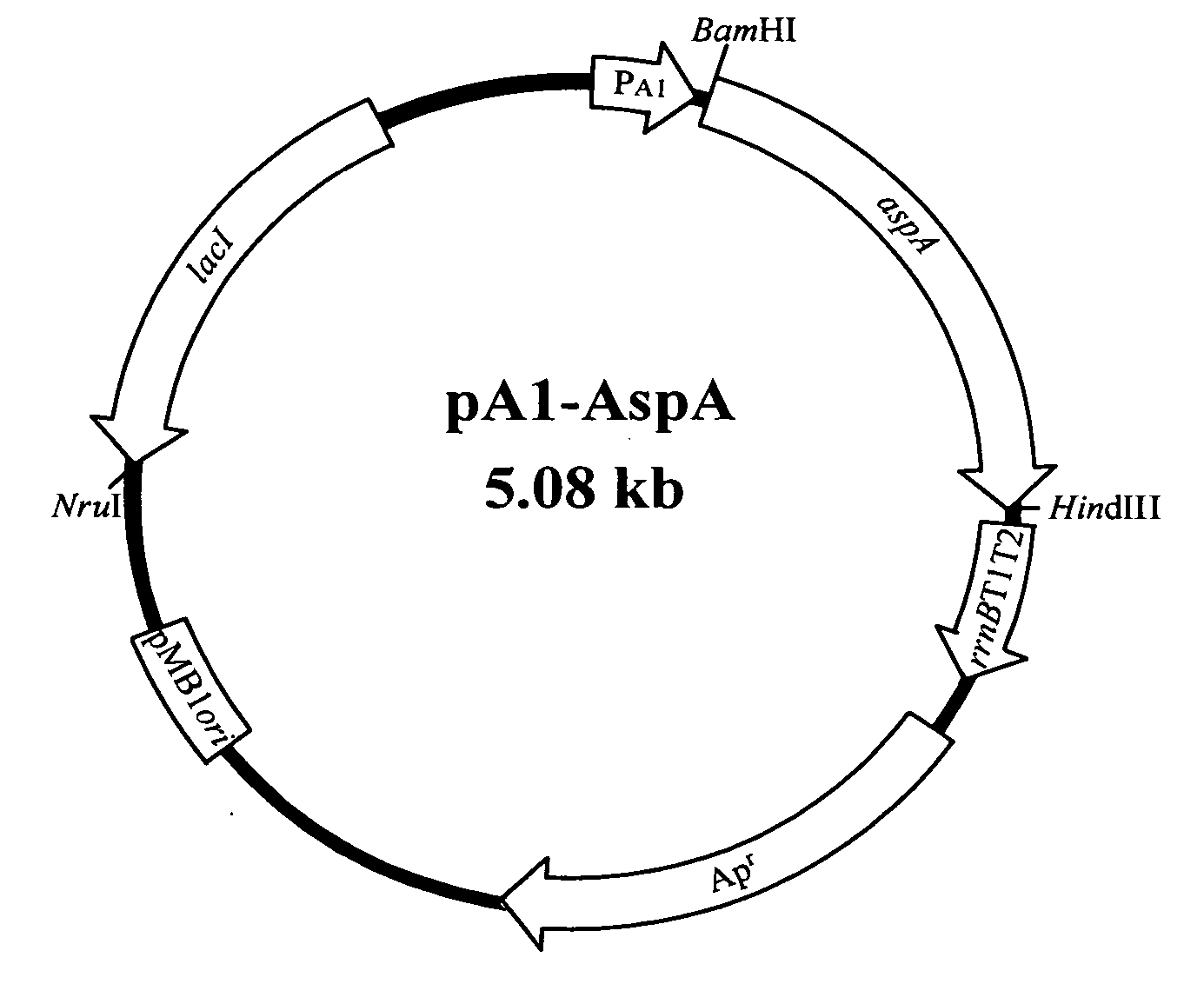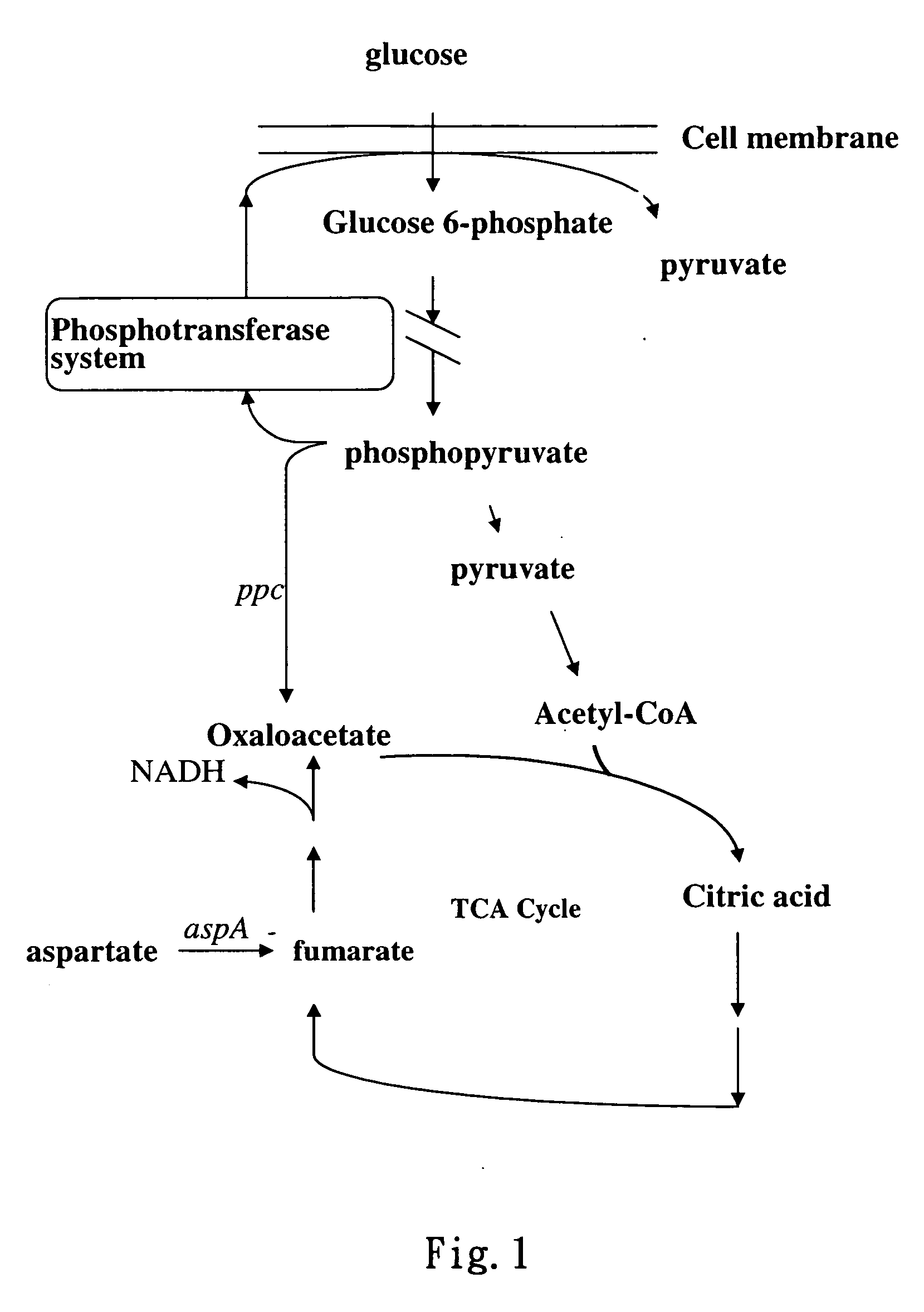Method for promoting cell growth and increasing the production of the expressed target gene products
a technology of target gene and cell growth, applied in the field of recombinant vectors, can solve the problems of restricting the production of recombinant proteins in i>, and achieve the effects of improving the characteristics of protein production, increasing the final cell density, and low production level of aspartas
- Summary
- Abstract
- Description
- Claims
- Application Information
AI Technical Summary
Benefits of technology
Problems solved by technology
Method used
Image
Examples
example 1
Construction of Plasmids Containing Aspartase Structural Gene (aspA)
[0054] The intermediate cells used for DNA cloning in the present example were E. coli XLI-Blue (Stratagene Co.).The bacteria strain was cultured in Luria-Bertani (LB) medium (containing yeast extract (5 g / L), tryptone (10 g / L), NaCl (5 g / L)) under 37° C. (Miller, J. H. (1972), Experiments in Molecular Genetics, Cold Spring Harbor Laboratory, Cold Spring Harbor, N.Y.). Transformed E. coli were cultured in the LB with antibiotics, and the used antibiotics included ampicillin, chloramphenicol and kanamycin and the amount used were 50, 20 and 25 μg / ml, respectively.
[0055] A. Construction of the Recombinant Plasmid, pA1-AspA, Containing Aspartase Gene (aspA)
[0056] According to FIG. 3, high-copy-number plasmid pA1-AspA used in the example comprises a T7 A1 promoter, lacI repression gene and pMB1 origin of replication. Product of lacI repression gene can control T7 A1 promoter to regulate the expression of aspartase (E...
example 2
Production of Aspartase in E. coli
[0061] According to Methods and Materials, plasmids pA199A-2, pA1-AspA, pACYC184 and pACYC-AspA from example 1 were transformed into E. coli strain VJS676 and recombinant strains VJS676 / pA199A-2, VJS676 / pA1-AspA, VJS676 / pACYC184 and VJS676 / pACYC-AspA were obtained in the present example.
[0062] Colonies selected from agar plates were inoculated into 5 ml LB with 50 μg / ml ampicillin or 20 μg / ml chloramphenicol at 37° C. for overnight. Thereafter, the cultured cells were inoculated into a 250 ml flask with 25 ml LB medium (containing 50 μg / ml ampicillin or 20 μg / ml chloramphenicol). The initial cell density was set at 0.05 (OD550), and the inoculated cells were cultured in a shaking incubator with 250 rpm at 37° C. Upon cell density reaches 0.3 (OD550), different concentrations of IPTG were added into culture medium to induce recombinant strain for the production of recombinant proteins. The cell growth was monitored along the time course. 6 hours af...
example 3
Production of Aspartase to Improve Cell Growth
[0066] In the control experiment of present invention, the culture method for recombinant strains VJS676 / pA199A-2 and VJS676 / pA1-AspA was the same as that in example 2. The medium used is M9 (Miller, J. H. (1972) Experiments in Molecular Genetics, Cold Spring Harbor Laboratory, Cold Spring Harbor, N.Y.) plus glucose (0.1%) and ampicillin (15 μg / mL). The medium M9 contains Na2HPO4 (6 g / L), KH2PO4 (3 g / L), NaCl (0.5 g / L), NH4Cl (1 g / L), MgSO4·7H2O (1 mM) and CaCl2 (0.1 mM). When the cell density of freshly inoculated bacteria achieved around 0.3 (OD550), 300 μM IPTG was added into culture medium to induce the production of recombinant proteins in the cells, and cell density was measured along with time. From the growth curve in FIG. 7, after IPTG induction, growth of the aspartase-producing strain VJS676 / pA1-AspA (⋄) became slow. The cell density reached only 0.9 (OD550) after fermentation for 10 hours. However, during the same fermentati...
PUM
| Property | Measurement | Unit |
|---|---|---|
| pH | aaaaa | aaaaa |
| pH | aaaaa | aaaaa |
| wave length | aaaaa | aaaaa |
Abstract
Description
Claims
Application Information
 Login to View More
Login to View More - R&D
- Intellectual Property
- Life Sciences
- Materials
- Tech Scout
- Unparalleled Data Quality
- Higher Quality Content
- 60% Fewer Hallucinations
Browse by: Latest US Patents, China's latest patents, Technical Efficacy Thesaurus, Application Domain, Technology Topic, Popular Technical Reports.
© 2025 PatSnap. All rights reserved.Legal|Privacy policy|Modern Slavery Act Transparency Statement|Sitemap|About US| Contact US: help@patsnap.com



